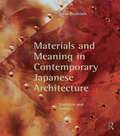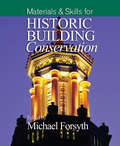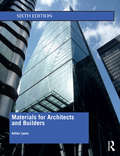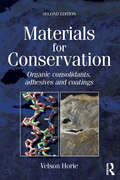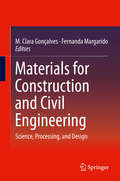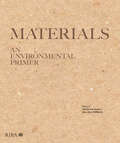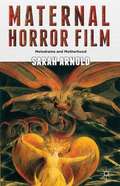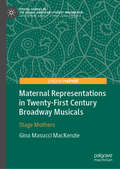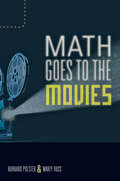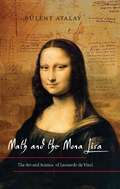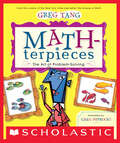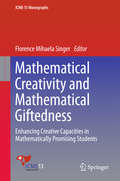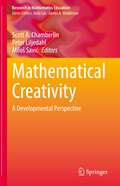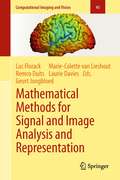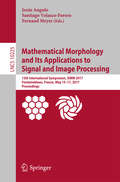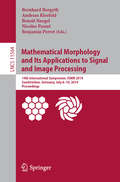- Table View
- List View
Materials and Interior Design
by Rachael BrownThe choice of materials is critical to the success of an interior. This book examines every aspect of the the use of materials in interior design, from initial concept and selection to visual representation and practical application. Following a brief introduction, the first five sections offer historical context and detailed guidance on selection, application, representation, communication, and sources, while the sixth and final section features case studies by international interior designers. The book includes useful step-by-step sequences, information on properties and sustainability, and a list of resources, online archives and sample libraries. It is an invaluable practical and inspirational guide for interior design students.
Materials and Interior Design (Portfolio Skills)
by Lorraine Farrelly Rachael BrownThe choice of materials is critical to the success of an interior. This book examines every aspect of the the use of materials in interior design, from initial concept and selection to visual representation and practical application. Following a brief introduction, the first five sections offer historical context and detailed guidance on selection, application, representation, communication, and sources, while the sixth and final section features case studies by international interior designers. The book includes useful step-by-step sequences, information on properties and sustainability, and a list of resources, online archives and sample libraries. It is an invaluable practical and inspirational guide for interior design students.
Materials and Interior Design (Portfolio Skills)
by Lorraine Farrelly Rachael BrownThe choice of materials is critical to the success of an interior. This book examines every aspect of the the use of materials in interior design, from initial concept and selection to visual representation and practical application. Following a brief introduction, the first five sections offer historical context and detailed guidance on selection, application, representation, communication, and sources, while the sixth and final section features case studies by international interior designers. The book includes useful step-by-step sequences, information on properties and sustainability, and a list of resources, online archives and sample libraries. It is an invaluable practical and inspirational guide for interior design students.
Materials and Meaning in Contemporary Japanese Architecture: Tradition and Today
by Dana BuntrockIn this beautiful and perceptive book, Dana Buntrock examines, for the first time, how tradition is incorporated into contemporary Japanese architecture. Looking at the work of five architects – Fumihiko Maki, Terunobu Fujimori, Ryoji Suzuki, Kengo Kuma, and Jun Aoki – Buntrock reveals the aims influencing many wonderful works barely known in the West; the sensual side of Japanese architecture borne out of approaches often less concerned with professionalism than with people and place. The buildings described in this book illustrate an architecture that embraces uniqueness, expressing unusual stories in the rough outlines of rammed earth and rust, and demonstrating new paths opening up for architectural practice today. For some, these examples will offer new insight into expressions of tradition in Japanese architecture; for others, this book offers inspiration for their own efforts to assert the unique heritage of other regions around the world. Compelling, insightful and groundbreaking, this book is essential for everyone studying Japanese architecture and anyone trying to invoke narrative and tradition in contemporary design.
Materials and Skills for Historic Building Conservation (Historic Building Conservation)
by Michael ForsythThis book is the third in a series of volumes that combine conservation philosophy in the built environment with knowledge of traditional materials, and structural and constructional conservation techniques and technology: Understanding Historic Building Conservation Structures & Construction in Historic Building Conservation Materials & Skills for Historic Building Conservation The series aims to introduce each aspect of conservation and to provide concise, basic and up-to-date knowledge for architects, surveyors and engineers as well as for commissioning client bodies, managers and advisors. In each book, Michael Forsyth draws together chapters by leading architects, structural engineers and related professionals to reflect the interdisciplinary nature of conservation work. The books are structured to be of direct practical application, taking the reader through the process of historic building conservation and emphasising throughout the integrative teamwork involved. The present volume - Materials & Skills for Historic Building Conservation – describes the characteristics and process of decay of traditional materials which inform the selection of appropriate repair techniques. It provides essential information on the properties of the principal traditional external building materials. Their availability, sourcing and environmental impact is covered, as well as the causes of erosion and decay, and the skills required for their application on conservation projects. It covers the main most commonly used materials and conservation techniques including stone, brickwork, lime products, concrete, iron and steel, timber, wattle and daub, and glass, Thirteen chapters written by the experts present today's key issues in materials and skills for historic building conservation: Gus Astley, Patrick Baty, Charley Brentnall, Michael Bussell, Michael Forsyth, Tony Graham, Chris Harris, David McLaughlin, Brian Ridout, Mike Stock, Geoff Wallis, Ian Williams, Rory Young
Materials for Architects and Builders
by Arthur LyonsMaterials for Architects and Builders provides a clear and concise introduction to the broad range of materials used within the construction industry and covers the essential details of their manufacture, key physical properties, specification and uses. Understanding the basics of materials is a crucial part of undergraduate and diploma construction or architecture-related courses, and this established textbook helps the reader to do just that with the help of colour photographs and clear diagrams throughout. This new 6th edition has been completely revised and updated to include the latest developments in materials research, new images, appropriate technologies and relevant legislation. The ecological effects of building construction and lifetime use remain an important focus, and this new edition includes a wide range of energy saving building components.
Materials for Conservation
by C V HorieMaterials in Conservation is the definitive introduction to the properties of materials used in conservation. The continual struggle of conservators to ameliorate the deterioration of objects has led to increasing use of synthetic polymers. These materials are part of the sophisticated technology that has been developed to augment and often replace traditional materials and methods. Conservators therefore have a wider range of techniques available. However, they must be able to appreciate the potentials and pitfalls of any proposed technique. The first section explains physical and chemical properties which are important in the conservation process, i.e. application, ageing, reversal. The topics covered include molecular weight, glass transition temperature, solubility and solvents, polymerisation and degradation reactions. The second section provides a detailed consideration of the individual materials, current and obsolete, used in conservation, drawing out the factors relevant to their effects on objects. The conservation uses of each material are summarised and referenced to allow further study. In five appendices, the properties of the polymers, solvents and their interactions are tabulated, with a list of suppliers and conversion table of physical units. IUPAC and SI nomenclature is used throughout the book. In this second edition, this classic text is revised and updated to include modern materials such as cyclododecane, and current ideas on adhesion, consolidation and reversibility, making Materials in Conservation the definitive source of vital information in the field. This handy reference book should be on the bench of every conservator and available wherever objects, from steam engines to dried plants, are preserved.
Materials for Construction and Civil Engineering
by M. Clara Gonçalves Fernanda MargaridoThis expansive volume presents the essential topics related to construction materials composition and their practical application in structures and civil installations. The book's diverse slate of expert authors assemble invaluable case examples and performance data on the most important groups of materials used in construction, highlighting aspects such as nomenclature, the properties, the manufacturing processes, the selection criteria, the products/applications, the life cycle and recyclability, and the normalization. Civil Engineering Materials: Science, Processing, and Design is ideal for practicing architects; civil, construction, and structural engineers, and serves as a comprehensive reference for students of these disciplines. This book also: · Provides a substantial and detailed overview of traditional materials used in structures and civil infrastructure · Discusses properties of natural and synthetic materials in construction and materials' manufacturing processes · Addresses topics important to professionals working with structural materials, such as corrosion, nanomaterials, materials life cycle, not often covered outside of journal literature · Diverse author team presents expect perspective from civil engineering, construction, and architecture · Features a detailed glossary of terms and over 400 illustrations
Materials for Design 2
by Patrick Rand Victoria Ballard BellAs architecture and design programs throughout the world break out of the classroom and adopt the holistic methods of design/build programs, the need for a textbook that bridges the gap between construction materials and design sensibility is sorely needed. <p><p>In Materials for Design 2, authors Victoria Ballard Bell and Patrick Rand revisit the format of their award-winning first volume and present sixty new case studies of materials put to imaginative use by today's brightest architects. Bell and Rand introduce each material type—glass, concrete, wood, metal, plastic, and stone—with new text describing its history and significance. Accessible case studies highlight recent advances in design and construction around the world—from a wooden church in Finland and huts in Thailand to a bank encased in a glass cube in Denmark. <p><p>In a materials landscape that constantly changes to meet the demands of contemporary designers, Materials for Design 2 is an up-to-date guide to the best and most exciting materials at their disposal.
Materials for Interior Environments
by Corky BinggeliOrganized by types of materials and applications, this guide helps designers successfully address material evaluation and selection of interior components. Engagingly written, highly detailed, and helpfully illustrated with more than 550 color illustrations, Materials for Interior Environments is a comprehensive guide to everything a designer needs to know about the materials available for interiors--from aesthetic qualities to manufacturing and fabrication, applications, installation and maintenance, and specifications for materials used in commercial and residential applications.
Materials for Learning: How to Teach Adults at a Distance (Routledge Library Editions: Broadcasting #26)
by Janet JenkinsMaterials for Learning (1981) examines the ability of books and broadcasts to change lives. The combination of print, radio, television and group meetings – distance teaching – can transform education in developing countries. Effective distance teaching requires effective teaching materials, and up to now there has been a lack of guidance about how to produce such materials and how to do so for different cultures. Materials for Learning aims to supply this need by suggesting guidelines for action and, where evidence is mixed or lacking, defining questions that still require answers. It is a practical book aimed at people actively involved in nonformal education and will be particularly useful for the developing world educators. The book looks first at how distance teaching can help with educational problems, considers how adults learn, and surveys problems of language and culture. It then considers the planning of distance teaching and looks in detail at the use of different media. There were also chapters on teaching numeracy and science at a distance, and a discussion of the kind of support that can be provided for people studying at a distance.
Materials, Specification and Detailing: Foundations of Building Design (Technologies of Architecture #Vol. 3)
by Norman WienandContinuing in the holistic philosophy of the Technologies of Architecture series, this volume examines the various layers of knowledge, skills and mechanisms that make up the many approaches to the essential function of technical design in the creation of successful buildings. Well-illustrated with case studies, the author draws on his extensive experience in architectural education to provide a detailed description of the development process, acknowledging traditional solutions whilst also encouraging designers to consider innovative alternatives. Attention is paid to materials choices, detail design and specification writing. Students of architectural technology in particular, but also of architecture, building surveying and construction will find this syllabus-relevant title an invaluable asset in embracing their environmental responsibilities as designers and actively participating in the development of technical design language.
Materials: An environmental primer
by Hattie Hartman Joe Jack WilliamsThe environmental impacts of construction are momentous. How can architects minimise these by making responsible material choices? Material choices have a global impact. The design and construction industry are responsible for 39% of all carbon emissions in the world. Despite the great desire among architects to address this, it can be difficult to compare materials directly, let alone understand the repercussions of selecting materials for use in different parts of a building or of sourcing them from across the world. Showcasing the latest thought leadership from subject experts across the industry, this primer sets out the various considerations and parameters for specifying a particular material. It empowers architects with the knowledge of which materials are available, how best to use them, and what their future holds as the industry continues to innovate. Each chapter will be devoted to a single material and will consider environmental impacts holistically, looking at health and biodiversity impacts, among other issues. Featuring: Chapters written by subject experts, including: Duncan Baker-Brown, Carol Costello, Graham Coult, Barbara Jones, Rowland Keable, Bruce Martin, Michael Stacey and Oliver Wilton. Mainstream and burgeoning materials, including: aluminium, bamboo, brick, concrete, cork, hemp, mycelium, plastics, steel, stone and timber. Diagrams, graphics and illustrated exemplars.
Maternal Horror Film
by Sarah ArnoldMaternal Horror Film: Melodrama and Motherhood examines the function of the mother figure in horror film. Using psychoanalytic film theory as well as comparisons with the melodrama film, Arnold investigates the polarized images of monstrous and sacrificing mother.
Maternal Performance: Feminist Relations (Contemporary Performance InterActions)
by Lena Šimić Emily Underwood-LeeMaternal Performance: Feminist Relations bridges the fields of performance, feminism, maternal studies, and ethics. It loosely follows the life course with chapters on maternal loss, pregnancy, birth, aftermath, maintenance, generations, and futures. Performance and the maternal have an affinity as both are lived through the body of the mother/artist, are played out in real time, and are concerned with creating ethical relationships with an other – be that other the child, the theatrical audience, or our wider communities. The authors contend that maternal performance takes the largely hidden, private and domestic work of mothering and makes it worthy of consideration and contemplation within the public sphere.
Maternal Representations in Twenty-First Century Broadway Musicals: Stage Mothers (Pivotal Studies in the Global American Literary Imagination)
by Gina Masucci MacKenzieMaternal Representations in Twenty-First Century Broadway Musicals: Stage Mothers analyzes Broadway productions within the context of their presentation and assessment of motherhood and the variety of roles for mother figures. Using a frame of feminist and psychoanalytical positions, Gina MacKenzie establishes, defines, and interprets mother figures in contemporary Broadway, according to original categorizations of the absent, inconsequential, and overbearing mothers. MacKenzie considers how and why commercial representation of mother figures are limited and predominantly negative, even as fiction, poetry, and other forms of drama offer a much wider and progressive view of the varieties of motherhood possible in society, asserting the need for greater representation of mother figures in commercial musical theatre today.
Math Goes to the Movies
by Burkard Polster Marty RossMel Gibson teaching Euclidean geometry, Meg Ryan and Tim Robbins acting out Zeno's paradox, Michael Jackson proving in three different ways that 7 x 13 = 28. These are just a few of the intriguing mathematical snippets that occur in hundreds of movies. Burkard Polster and Marty Ross pored through the cinematic calculus to create this thorough and entertaining survey of the quirky, fun, and beautiful mathematics to be found on the big screen. Math Goes to the Movies is based on the authors' own collection of more than 700 mathematical movies and their many years using movie clips to inject moments of fun into their courses. With more than 200 illustrations, many of them screenshots from the movies themselves, this book provides an inviting way to explore math, featuring such movies as:• Good Will Hunting• A Beautiful Mind• Stand and Deliver• Pi• Die Hard• The Mirror Has Two FacesThe authors use these iconic movies to introduce and explain important and famous mathematical ideas: higher dimensions, the golden ratio, infinity, and much more. Not all math in movies makes sense, however, and Polster and Ross talk about Hollywood's most absurd blunders and outrageous mathematical scenes. Interviews with mathematical consultants to movies round out this engaging journey into the realm of cinematic mathematics.This fascinating behind-the-scenes look at movie math shows how fun and illuminating equations can be.
Math and the Mona Lisa: The Art and Science of Leonardo da Vinci
by Bulent AtalayLeonardo da Vinci was one of history's true geniuses, equally brilliant as an artist, scientist, and mathematician. Readers of The Da Vinci Code were given a glimpse of the mysterious connections between math, science, and Leonardo's art. Math and the Mona Lisa picks up where The Da Vinci Code left off, illuminating Leonardo's life and work to uncover connections that, until now, have been known only to scholars. Bülent Atalay, a distinguished scientist and artist, examines the science and mathematics that underlie Leonardo's work, paying special attention to the proportions, patterns, shapes, and symmetries that scientists and mathematicians have also identified in nature. Following Leonardo's own unique model, Atalay searches for the internal dynamics of art and science, revealing to us the deep unity of the two cultures. He provides a broad overview of the development of science from the dawn of civilization to today's quantum mechanics. From this base of information, Atalay offers a fascinating view into Leonardo's restless intellect and modus operandi, allowing us to see the source of his ideas and to appreciate his art from a new perspective.From the Hardcover edition.
Math-terpieces
by Greg Tang Greg PaprockiNEW YORK TIMES bestselling author Greg Tang challenges kids to solve problems creatively while introducing art history.In his most ground-breaking book since THE BEST OF TIMES (Fall 2002), Greg Tang underscores the importance of four basic rules in problem-solving. Keeping an open mind, looking for unusual number combinations, using multiple skills (like subtracting to add) and looking for patterns, will guarantee any child success in math. In MATH-TERPIECES, Tang continues to challenge kids with his innovative approach to math, and uses art history to expand his vision for creative problem-solving.
Mathematical Creativity and Mathematical Giftedness: Enhancing Creative Capacities In Mathematically Promising Students (ICME-13 Monographs)
by Florence Mihaela SingerThis book discusses the relationships between mathematical creativity and mathematical giftedness. It gathers the results of a literature review comprising all papers addressing mathematical creativity and giftedness presented at the International Congress on Mathematical Education (ICME) conferences since 2000. How can mathematical creativity contribute to children’s balanced development? What are the characteristics of mathematical giftedness in early ages? What about these characteristics at university level? What teaching strategies can enhance creative learning? How can young children’s mathematical promise be preserved and cultivated, preparing them for a variety of professions? These are some of the questions addressed by this book. The book offers, among others: analyses of substantial learning environments that promote creativity in mathematics lessons; discussions of a variety of strategies for posing and solving problems; investigations of students’ progress throughout their schooling; and examinations of technological tools and virtual resources meant to enhance learning with understanding. Multiple perspectives in the interdisciplinary fields of mathematical creativity and giftedness are developed to offer a springboard for further research. The theoretical and empirical studies included in the book offer a valuable resource for researchers, as well as for teachers of gifted students in specialized or inclusive settings, at various levels of education.
Mathematical Creativity: A Developmental Perspective (Research in Mathematics Education)
by Peter Liljedahl Miloš Savić Scott A. ChamberlinThis book is important and makes a unique contribution in the field of mathematics education and creativity. The book comprises the most recent research by renowned international experts and scholars, as well as a comprehensive up to date literature review. The developmental lens applied to the research presented makes it unique in the field. Also, this book provides a discussion of future directions for research to complement what is already known in the field of mathematical creativity. Finally, a critical discussion of the importance of the literature in relation to development of learners and accordingly pragmatic applications for educators is provided. Many books provide the former (2) foci, but omit the final discussion of the research in relation to developmental needs of learners in the domain of mathematics. Currently, educators are expected to implement best practices and illustrate how their adopted approaches are supported by research. The authors and editors of this book have invested significant effort in merging theory with practice to further this field and develop it for future generations of mathematics learners, teachers and researchers.
Mathematical Methods for Signal and Image Analysis and Representation
by Luc Florack Marie-Colette van Lieshout Remco Duits Geurt Jongbloed Laurie DaviesMathematical Methods for Signal and Image Analysis and Representation presents the mathematical methodology for generic image analysis tasks. In the context of this book an image may be any m-dimensional empirical signal living on an n-dimensional smooth manifold (typically, but not necessarily, a subset of spacetime). The existing literature on image methodology is rather scattered and often limited to either a deterministic or a statistical point of view. In contrast, this book brings together these seemingly different points of view in order to stress their conceptual relations and formal analogies. Furthermore, it does not focus on specific applications, although some are detailed for the sake of illustration, but on the methodological frameworks on which such applications are built, making it an ideal companion for those seeking a rigorous methodological basis for specific algorithms as well as for those interested in the fundamental methodology per se. Covering many topics at the forefront of current research, including anisotropic diffusion filtering of tensor fields, this book will be of particular interest to graduate and postgraduate students and researchers in the fields of computer vision, medical imaging and visual perception.
Mathematical Methods for Signal and Image Analysis and Representation (Computational Imaging and Vision #41)
by Luc Florack Marie-Colette van Lieshout Remco Duits Geurt Jongbloed Laurie DaviesMathematical Methods for Signal and Image Analysis and Representation presents the mathematical methodology for generic image analysis tasks. In the context of this book an image may be any m-dimensional empirical signal living on an n-dimensional smooth manifold (typically, but not necessarily, a subset of spacetime). The existing literature on image methodology is rather scattered and often limited to either a deterministic or a statistical point of view. In contrast, this book brings together these seemingly different points of view in order to stress their conceptual relations and formal analogies.Furthermore, it does not focus on specific applications, although some are detailed for the sake of illustration, but on the methodological frameworks on which such applications are built, making it an ideal companion for those seeking a rigorous methodological basis for specific algorithms as well as for those interested in the fundamental methodology per se.Covering many topics at the forefront of current research, including anisotropic diffusion filtering of tensor fields, this book will be of particular interest to graduate and postgraduate students and researchers in the fields of computer vision, medical imaging and visual perception.
Mathematical Morphology and Its Applications to Signal and Image Processing: 13th International Symposium, ISMM 2017, Fontainebleau, France, May 15–17, 2017, Proceedings (Lecture Notes in Computer Science #10225)
by Jesús Angulo, Santiago Velasco-Forero and Fernand MeyerThis book contains the refereed proceedings of the 13th International Symposium on Mathematical Morphology, ISMM 2017, held in Fontainebleau, France, in May 2017. The 36 revised full papers presented together with 4 short papers were carefully reviewed and selected from 53 submissions. The papers are organized in topical sections on algebraic theory, max-plus and max-min mathematics; discrete geometry and discrete topology; watershed and graph-based segmentation; trees and hierarchies; topological and graph-based clustering, classification and filtering; connected operators and attribute filters; PDE-based morphology; scale-space representations and nonlinear decompositions; computational morphology; object detection; and biomedical, material science and physical applications.
Mathematical Morphology and Its Applications to Signal and Image Processing: 14th International Symposium, ISMM 2019, Saarbrücken, Germany, July 8-10, 2019, Proceedings (Lecture Notes in Computer Science #11564)
by Bernhard Burgeth Andreas Kleefeld Benoît Naegel Nicolas Passat Benjamin PerretThis book contains the refereed proceedings of the 14th International Symposium on Mathematical Morphology, ISMM 2019, held in Saarbrücken, Germany, in July 2019. The 40 revised full papers presented together with one invited talk were carefully reviewed and selected from 54 submissions. The papers are organized in topical sections on Theory, Discrete Topology and Tomography, Trees and Hierarchies, Multivariate Morphology, Computational Morphology, Machine Learning, Segmentation, Applications in Engineering, and Applications in (Bio)medical Imaging.

